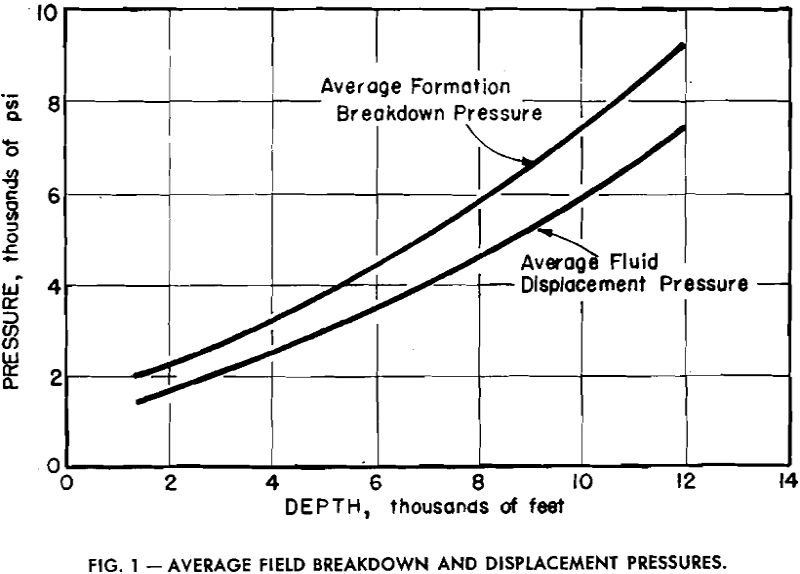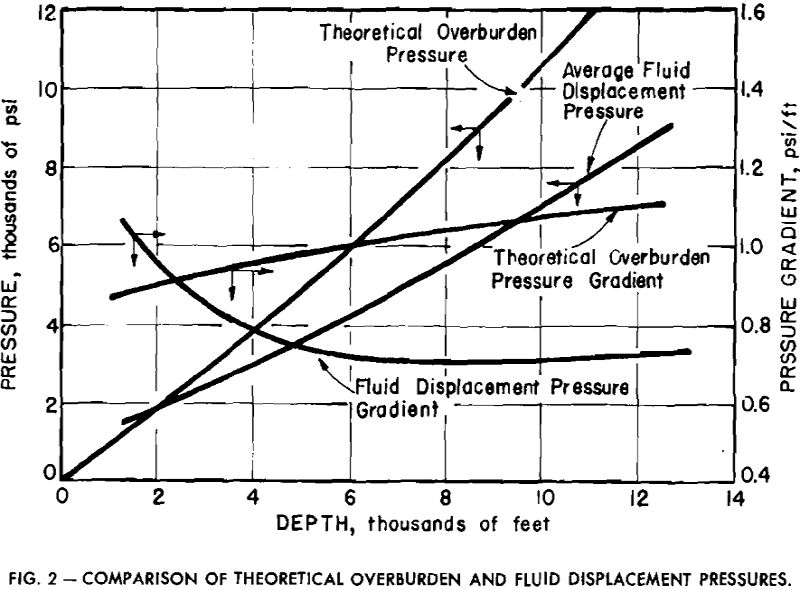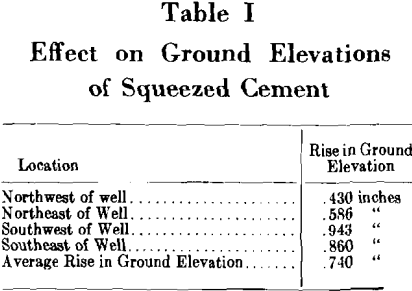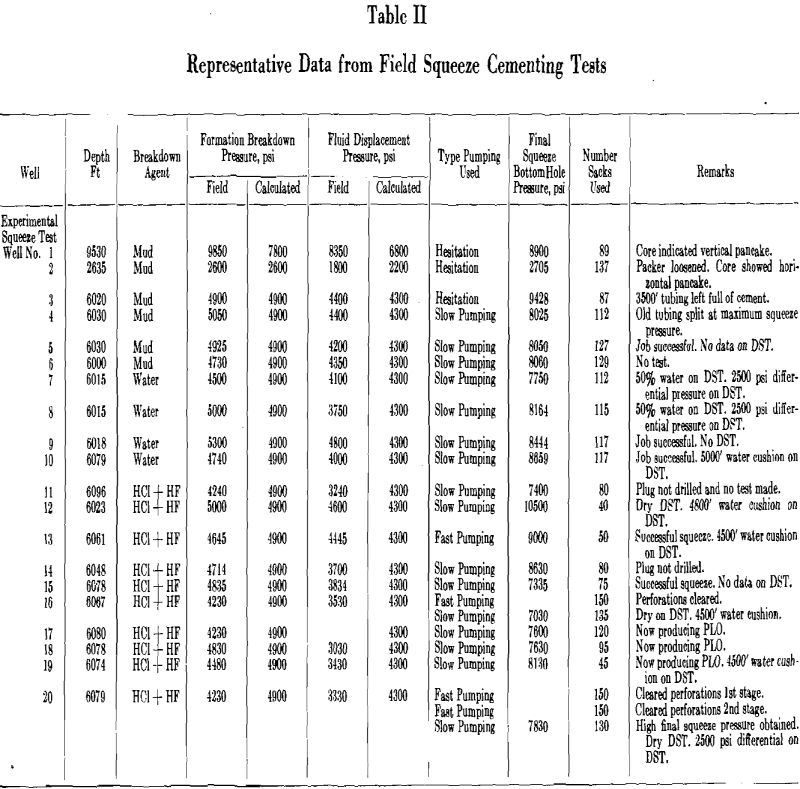Table of Contents
Laboratory and field testing of various squeeze cementing techniques and materials revealed that many improvements could be made in squeeze cementing operations. The use of a slow-pumping squeeze cementing procedure permitted the control of the quantity of cement displaced into a formation and aided in obtaining a high final squeeze pressure. Field testing indicated the desirability of obtaining high final squeeze pressures, the need for improved formation breakdown fluids, and the necessity of controlling the pressure differential during testing after a squeeze job.
Preliminary Studies
Squeeze cementing problems are so intimately related to the earth’s overburden pressure that solutions to them are very difficult, if not impossible, without an understanding of the nature and magnitude of the overburden pressures encountered at the depths of producing wells. It was thus felt that the first approach to research on squeeze cementing should be made through a study of these pressures.
Since there has been rather loose usage of a number of the terms related to overburden pressure by different writers, the terms to be subsequently used are defined here.
Theoretical overburden pressure is the calculated pressure at any given depth exerted by the theoretical weight of overlying formations as calculated from the average rock density.
Fluid displacement pressure is that pressure at which fluid can be injected into a formation after it has been broken down. It may be more or less than the theoretical overburden pressure.
Formation breakdown pressure is that pressure at which a formation parts or breaks and is usually thought of as fluid displacement pressure plus rock strength.
Breakdown agent is that fluid with which the formation is fractured.
The first step in the study of the earth’s overburden pressures involved a review of pertinent technical literature. The general opinion expressed was that the overburden pressure gradient of the earth’s formations is roughly 1.0 psi per foot of depth, and that application of sufficient pressure to stratified formations will cause them to part at or parallel to the bedding planes.
The second step in the study of overburden pressures involved a study of available well data in an effort to obtain some definite information as to the actual values experienced in the field for the above mentioned terms. Data from 115 cement squeeze jobs in the Gulf Coast area and 46 cement squeeze jobs and acid jobs in the West Texas-New Mexico area were closely analyzed.
The analysis of these data showed that the average formation breakdown pressure prior to squeeze cementing was less than 1.0 psi/ft of depth. The fluid displacement pressures, however, varied so greatly with depth due to structural stresses in the earth and elasticity of the earth’s formations, that they could not be defined in general terms. For example, they were found to vary from 0.75 to 1.11 psi/ft at 2,000 ft, and from 0.57 to 0.85 psi/ft at 8,000 ft. Neither formation breakdown nor fluid displacement pressures varied linearly with depth. In general, it was found that the effective overburden pressure at a given depth, as determined from field data, was less than the theoretical pressure or the pressure calculated from the rock densities.
The first point investigated in the shallow well tests was the question of where cement goes during a squeeze job. There are three main schools of thought on this question. One group holds that cement slurry squeezed against formations tends to compress soft sands and shales around the well bore thereby enlarging it.


These data strongly indicate that the cement slurry was squeezed out in a horizontal sheet or “pancake” parallel to the bedding planes and actually lifted the overburden. This proved to be the case when this well was excavated to observe the results. A cement pancake 1½ in. to 2 in. thick, with a lateral spread of 360° around the well bore, was found just below the casing seat. This cement spread laterally from the well bore more than five ft (extent of the excavation) in all directions.
After determining in these shallow well tests that the majority of the squeezed cement slurry traveled in a horizontal direction from the well bore, the question arose as to where the cement goes when a well is squeezed and resqueezed at the same level. To investigate this problem a well was drilled to a total depth of 7 ft, 3-in. pipe set and cemented, and the well deepened approximately one foot. This well was squeeze cemented three times with different colored cement for purposes of identification. Red slurry was used on the first job, after breaking down with water, and nearly a cubic foot of slurry was displaced at a pressure of 50 psi before the pressure built up to approximately 500 psi. cementing job.

Mud, on the other hand, will break down highly permeable formations, and in field usage is believed to be less likely to damage oil sands, especially if the mud has low-water-loss characteristics. The injection of mud ahead of cement on squeeze jobs is likely to fracture the formation a greater lateral distance than would water. However, the mud film left on the face of the formation and on the primary cement sheath will tend to prevent a tight bond between the squeezed cement, cement sheath, and the formation. Experimental squeeze jobs in shallow wells at the laboratory, where the effects of breaking down formations with mud were demonstrated, showed that cement will not bond to a cement sheath or sand face covered with mud.
The objective of some squeeze jobs is to displace the cement slurry into the formation at a given elevation to prevent the vertical migration of undesirable fluids. In order to determine the probability of success of this type of operation, a number of shallow well squeeze jobs were conducted.
Two methods were utilized to accomplish this purpose. In one method a special tool was used to V-notch the formation before it was broken down, to determine if the breakdown and subsequent cement pancake would be formed in the notch. Two squeeze jobs were conducted in a well under these conditions. In a second method, consisting of high density shooting, the casing was perforated at the desired level with 12 shots, approximately 30° apart, in a 2-in. band. Following this, the formation was broken down and the well squeeze cemented. Excavation of these two wells revealed that both of these attempts failed in their purpose. The cement pancake was opposite neither the notches nor the perforations because formation weaknesses found in both wells allowed the fracture to be formed more easily at other than the desired elevation.
Large quantities of cement were displaced into the formation by the use of low-water-loss cement. This is a special cement that has an API fluid loss of less than 100 cc in 30 minutes. Therefore, almost unlimited quantities of this cement can be placed without a pressure buildup because it will resist dehydration. Tests performed in a shallow well permitted the placement of 40 sacks of this cement, with five shutdowns ranging from 5 to 30 minutes without a pressure buildup in three hours of pumping. Yet when 10 sacks of standard portland cement were squeezed in a second well under similar conditions, the slurry dehydrated in 30 minutes with a pressure buildup of 2000 psi.
Field Investigation to Determine Proper Squeeze Cementing Methods
Reviewing the results obtained from the preliminary studies, it became apparent that the ability of a squeeze cement job to seal perforations is dependent upon the bond obtained between the squeezed cement and the primary cement sheath, rather than on the quantity of cement that can be displaced out into the formation. If the squeezed cement does not bond to the primary cement job, such as to prevent the entry of well fluids into the casing at this point, then all cement squeezed beyond this point serves very little purpose. The initial investigation also indicated that the quantity of cement required to obtain a high final squeeze pressure could be controlled by utilizing special squeeze cementing techniques.
It is realized that a definite evaluation of a squeeze cementing procedure should be based on the ability of the squeeze job to accomplish the desired results. However, on many of the squeeze jobs conducted during this series of field tests, well conditions prevented a uniform testing program following each job, making a definite evaluation of the various squeeze cementing procedures difficult. As past field experience has indicated that a large majority of the successful squeeze jobs was characterized by a high final squeeze pressure, it appeared that this factor might be used as a criterion for judging various squeeze cementing procedures. By accepting this line of reasoning, it was then possible to rate a given procedure on the number of sacks of cement with which a high final squeeze pressure was obtained. For example, at the present time only 100 to 125 sacks of cement are required for a squeeze job, as compared to the estimated 250 or more sacks previously-used.
An analysis of the fast pumping squeeze procedure used by the field, and the laboratory experiments previously described, suggested that part of the cement slurry on a field squeeze job was being displaced out into the formation away from the well bore. The pressure buildup was obtained only when sufficient water had been squeezed out of the cement slurry to leave a solid plug which resisted further movement and thus caused a buildup in pressure. The slow pumping procedure aided this rate of water loss by decreasing the displacement rate and allowing more time for the cement slurry to dehydrate. High final squeeze pressures were thus obtained with much smaller volumes of cement than had previously been possible.
During these field tests a study was made to determine if drillable or retrievable cement retainers affected squeeze jobs differently, or if one type of retainer would be preferable to the other. At the beginning of these observations it was the thought that the drillable type retainer might be superior to a retrievable retainer in that it provided a means for retention of the full final squeeze pressure on the slurry during the entire curing period of the cement. The use of a retrievable type retainer, however, required that all of the surface pressure be bled off before starting the retainer out of the well. An investigation of 109 squeeze jobs, where a retrievable retainer was used, revealed that only 12 of these jobs were failures.

